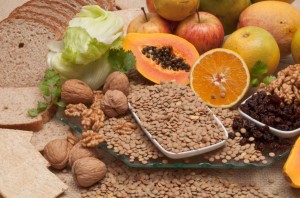Fiber is the part of plant foods that cannot be digested. It is divided into soluble and insoluble fiber. The difference is soluble fiber dissolves in water and turns into a gel like substance where insoluble fiber does not. Soluble fiber slows down digestion, helping us to feel full longer and has been associated with reducing cholesterol. Insoluble fiber adds bulk to the stool since it does not dissolve and helps food to move through the intestines more quickly maintaining a healthy intestinal tract.
fiber dissolves in water and turns into a gel like substance where insoluble fiber does not. Soluble fiber slows down digestion, helping us to feel full longer and has been associated with reducing cholesterol. Insoluble fiber adds bulk to the stool since it does not dissolve and helps food to move through the intestines more quickly maintaining a healthy intestinal tract.
Sources of fiber include: legumes, vegetables, fruit, and whole grains. Foods especially high in fiber include flax seed and psyllium. The FDA recommends on average of 20 to 30 grams of fiber in the diet; however, most Americans fail to reach this goal due to a diet high in refined grains. Refined grains have been milled to give grains a finer texture and to improve shelf life; however, in the process dietary fiber is also removed. Low fiber in the diet leads to constipation and the downstream effects from impaired elimination (removal of toxins from the body).
Bacteria that house our intestines feed on fiber and the by products are what keep our gut healthy. In particular, buytrate is a substance made by bacteria in the colon from fermentation of certain fibers and has anti-inflammatory and anti-oxidant effects. A study published in the American Journal of Clinical Nutrition suggests that the greater production of butyrate may explain why colon cancer is less common in native residents of Africa than African Americans. Although additional research is needed in this area, evidence is promising that butyrate made from fermentation of fiber may be protective against colon cancer.
At Hermann Aesthetics & Wellness we over comprehensive stool analysis that includes butyrate testing. Our offices are located in Tampa and St. Petersburg. Please call the office at 813- 902-9559 for more information or to schedule an appointment.





 Main Menu
Main Menu